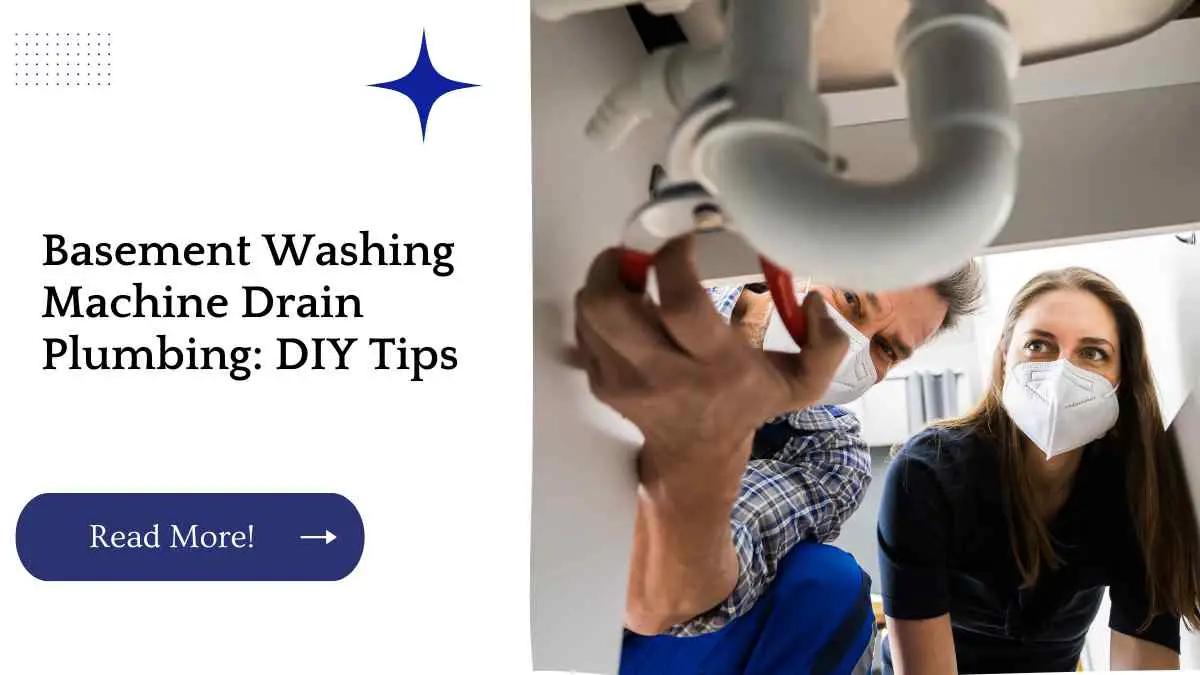If you have a washing machine in your basement, it’s essential to have proper drain plumbing to prevent flooding and water damage. In this article, we will provide you with some DIY tips on how to properly install and maintain your washing machine drain plumbing.
| Takeaways |
|---|
| Proper installation and maintenance of your washing machine drain plumbing are crucial to prevent water damage and prolong the life of your washing machine. |
| Understanding the washing machine drain system is essential to ensure proper installation and maintenance. |
| Common issues with washing machine drain plumbing include clogs, leaks, and flooding. |
| Proper preparation, including shutting off the water supply and measuring and cutting pipes, is necessary before installation. |
| Regular maintenance and testing of the drain system is crucial to prevent clogs and water damage. |
| Benefits of properly installed washing machine drain plumbing include preventing flooding and water damage and prolonging the life of your washing machine. |
Understanding the Washing Machine Drain System
Before starting any installation or maintenance, it’s essential to understand how the washing machine drain system works. Typically, the drain hose from your washing machine connects to a standpipe or a floor drain in your basement. The standpipe is a vertical pipe that extends from the drain trap to about three feet above the floor.
Are you dealing with a washing machine that drains into your sink instead of the designated drain? Check out our guide on how to fix this common plumbing issue for step-by-step solutions to get your washer draining where it should
Common Issues with Washing Machine Drain Plumbing
Improper installation or maintenance of your washing machine drain plumbing can lead to various issues. Some common problems include clogs, leaks, and flooding. These issues can cause water damage to your basement, foundation, and walls, leading to costly repairs.
Preparing for Installation
Proper preparation is crucial before starting any installation. You will need to gather the necessary tools and materials, shut off the water supply, and measure and cut pipes.
Leaky sink drains can be frustrating to deal with, but our DIY solutions can help you fix the problem without calling a plumber. Learn how to diagnose and solve your sink drain issues with ease.
Tools and Materials Needed
- Pipe cutter
- Teflon tape
- PVC pipes and fittings
- Drain trap
- Standpipe
- Screwdriver
Shutting Off the Water Supply
Before starting any installation or maintenance, make sure to shut off the water supply to your washing machine.
Measuring and Cutting Pipes
Measure the distance between the washing machine and the drain and cut the PVC pipes accordingly. Use a pipe cutter to ensure a clean cut.
Installing the Drain System
The installation of your washing machine drain system may involve connecting to existing pipes or installing a standpipe.
Connecting to Existing Pipes
If you have an existing drain line, you can connect the washing machine drain hose directly to the line. Use a drain trap to prevent sewer gases from entering your home.
Efficiently draining your washer and sink is crucial for a functional laundry area. Our tips for washing machine and sink drainage can help you optimize your setup and get the most out of your laundry space.
Installing a Standpipe
If you don’t have an existing drain line, you will need to install a standpipe. Cut a section of PVC pipe to the correct length and attach it to the drain trap. Make sure the standpipe is at least three feet above the floor to prevent flooding.
5. Testing and Maintenance
After installation, it is crucial to test the drain system and perform regular maintenance to prevent clogs and other issues.
Testing the Drain System
Run a load of laundry and observe the drain system’s performance. Check for any leaks or slow drainage. If you notice any issues, you may need to adjust the drain system or call a professional plumber for assistance.
Regular Maintenance
Regular maintenance can prevent clogs and other issues with your washing machine drain plumbing. Some tips include:
- Clean the drain trap regularly to prevent clogs.
- Use a lint filter on your washing machine to prevent lint from clogging the drain.
- Avoid pouring grease or other liquids down the drain.
Benefits of Properly Installed Washing Machine Drain Plumbing
Properly installed washing machine drain plumbing offers several benefits, including:
- Preventing flooding and water damage to your basement and foundation.
- Protecting your washing machine from damage due to improper drainage.
- Prolonging the life of your washing machine and other plumbing fixtures.
Don’t let common household problems like a malfunctioning fridge frustrate you – our troubleshooting guide can walk you through some easy fixes. From temperature issues to strange noises, we’ve got you covered.
Further Reading
For more information on basement washing machine drain plumbing, check out these helpful resources:
BathAdvice: This comprehensive guide covers everything you need to know about installing and maintaining your basement washing machine drain plumbing.
Angie’s List: This article offers tips and advice on how to properly plumb your washing machine drain, including information on drain traps and venting.
Fine Homebuilding: This article discusses the different options for draining a basement clothes washer, including information on standpipes and pumps.
Rusty screws on your bathtub’s overflow cover? No problem. Our quick and easy fixes can get it looking good as new. Check out our guide for tips on replacing the screws and giving your cover a refreshed look.
Frequently Asked Questions (FAQs)
How do I know if my washing machine drain is clogged?
You may notice slow drainage or standing water in your basement near the washing machine. If you suspect a clog, try running a plumbing snake or calling a professional plumber for assistance.
Can I use a flexible hose for my washing machine drain?
While flexible hoses are sometimes used for washing machine drain plumbing, they can be prone to clogging and leaking. It’s recommended to use rigid PVC pipes for a more reliable and durable solution.
Can I install a washing machine drain pump in my basement?
Yes, a washing machine drain pump can be installed in your basement if you don’t have an existing drain line or standpipe. However, this may require professional installation and can be a more expensive option.
Should I hire a professional plumber to install my washing machine drain plumbing?
While DIY installation is possible, it’s recommended to hire a professional plumber to ensure proper installation and avoid any potential issues down the line.
Can I use a washing machine without a drain pump in my basement?
It’s not recommended to use a washing machine without a drain pump in your basement. Without proper drainage, you risk flooding and water damage to your home and property.
In conclusion, proper installation and maintenance of your basement washing machine drain plumbing are crucial to prevent water damage and prolong the life of your washing machine. By following these DIY tips and taking the necessary precautions, you can ensure a reliable and efficient drain system for your washing machine.

Hellen James is the author of the blog and a licensed plumber with over 15 years of experience. She shares her knowledge and experience in plumbing and drainage through insightful and informative articles

